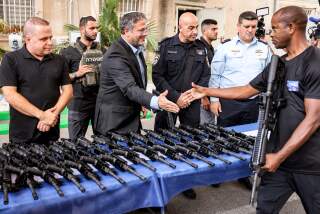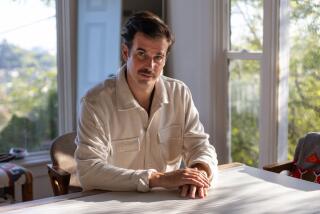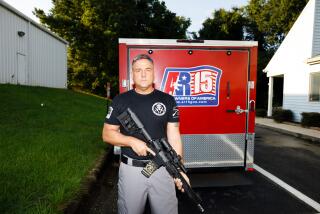Mikhail Kalashnikov dies at 94; creator of the AK-47 assault rifle
- Share via
Interviewers always asked Mikhail Kalashnikov the same question and he always gave the same answer: Yes, he could sleep at night. Quite easily, thank you.
Kalashnikov, creator of the AK-47, a cheap, simple, rugged assault rifle that became the weapon of choice for more than 50 standing armies as well as drug lords, street gangs, revolutionaries, terrorists, pirates and thugs the world over, died Monday at a hospital in Izhevsk, the capital of the Russian republic of Udmurtia, according to a government spokesman. Kalashnikov was 94.
Over six decades, the AK-47 — sometimes called the Kalashnikov — became a staple in guerrilla raids and gang drive-bys. It was so easy to operate that children as well as professional soldiers could fire 650 deadly bursts per minute.
In Vietnam, the Viet Cong used AK-47s while moisture and muck sometimes jammed more precise American M16s. In Rwanda, some 800,000 Tutsi villagers were slaughtered with machetes and AK-47s. With its distinctive banana-shaped clip, the weapon was a favorite of Yasser Arafat, Saddam Hussein and Osama bin Laden, who had one nearby in almost every photograph. In Africa, Mozambique placed a silhouetted AK-47 on its flag, crossed with a hoe.
A diminutive, white-haired man with the honorary rank of general, Kalashnikov was revered throughout Russia and the other republics of the former Soviet Union. A Kalashnikov museum in Izhevsk, the once-closed industrial city in the Urals where he spent much of his career, draws 10,000 visitors a month. Anniversaries of the gun’s 1947 birth are duly noted; at a ceremony for its 60th birthday in 2007, Russian President Vladimir Putin called it “a symbol of the creative genius of our people”.
In a November interview with the Los Angeles Times, Russian arms expert Igor Korotchenko called Kalashnikov one of the greatest weapons designers of all time.
“If Colt designed a handgun which made all Americans equal, Kalashnikov invented a weapon which made it possible for many countries to fight for their independence and win it,” said Korotchenko, a retired Russian colonel who edits Nastionalnaya Oborona, a Moscow-based national defense magazine.
Historians say the AK-47 and its spinoffs changed combat forever. While they aren’t as accurate as other guns or as effective at long distances, they weigh only eight pounds and have few moving parts. Child soldiers can take them apart and put them back together in 30 seconds. They can tolerate sand, grit, mud and humidity. They work just as well in jungle and swamp as on city streets.
“Together these traits meant that once this weapon was distributed, the small-statured, the mechanically disinclined, the dimwitted and the untrained might be able to wield, with little difficulty or instruction, a lightweight automatic rifle that could push out blistering fire for the lengths of two or three football fields,” wrote journalist C.J. Chivers in “The Gun”, his 2010 book about the AK-47.
On top of that, the AK-47 — short for Avtomat Kaloshnikova 1947 — is everywhere. It can be purchased in some countries for “less than the cost of a live chicken,” according to author Larry Kahaner. By some estimates, it is the world’s most abundant firearm, with one for every 70 of the men, women and children on Earth.
Its spread “helps explain why, since World War II, so many ‘small wars’ have lingered far beyond the months and years one might expect,” Kahaner wrote in the Washington Post. “Indeed, for all the billions of dollars Washington has spent on space-age weapons and military technology, the AK still remains the most devastating weapon on the planet, transforming conflicts from Vietnam to Afghanistan to Iraq.”
In news reports over the years, Kalashnikov appeared to be of mixed minds about his brainchild. At one point, he spoke of establishing a fund for gunshot victims.
“I am proud of my weapon but I am sad that terrorists use it,” he told the Russian online publication newsru.com in 2009. “I wish I had invented a machine which people could use, which could do good for farmers — for example, a sowing machine.”
But for the most part, he vigorously defended his namesake weapon.
“I designed the Kalashnikov for my motherland, for the glory of the Soviet army,” he said, choking with emotion during a 1997 interview with the Moscow Times. “If it has fallen into the wrong hands, that is not my business.”
In his later years, Kalashnikov was pleased to learn that former rebels in Africa were naming their firstborn sons “Kalash.”
And he was proud that his tiny hometown on the Russian steppes had erected a bronze bust of its most famous son.
Newlyweds dropped by to lay flowers beside it, he told the Associated Press in 2007.
“They whisper, ‘Uncle Misha, wish us happiness and healthy kids,’” he said. “What other gun designer can boast of that?”
Born on Nov. 10, 1919, in Kurya, a remote village in south central Russia, Mikhail Timofeyevich Kalashnikov was one of 18 children. Only eight survived to adulthood.
A sickly boy who built toy guns, he was the son of an illiterate mother and a barely literate father. After Stalin ordered the collectivization of farms in 1929, local officials slaughtered the Kalashnikovs’ animals, seized their hardscrabble property, and sent the family to Siberia, transported in cattle cars with other dispossessed farmers.
Kalashnikov made it through ninth grade, taught by deportees in a school that lacked even paper. His father, broken by the ordeal, died during a blizzard. For days, the family sat indoors with the body. Kalashnikov recalled a man who, in happier times, would break out in song.
“It seemed to me that I was just about to hear him say something softly in his confident, deep voice,” Kalashnikov wrote in “From a Stranger’s Doorstep to the Kremlin’s Gates”, a 1997 memoir. “But no, he did not sing of the ‘sacred Baikal,’ the tramp was not running down a narrow path, and the Cossack was not galloping across a valley.... There was only the vicious snowstorm raging around our hut.”
As a teenager, Kalashnikov fled 600 miles to his hometown, gazed at the ashes of his torched family home, and headed with a friend to Kazakhstan. He picked up a job as a clerk for the Turkestan-Siberian Railway and was recruited into the Young Communist League, but for decades afterward feared that his family’s exile would brand him an enemy of the state.
With World War II looming, he was drafted into the Soviet Army and was made a tank sergeant. Seriously wounded in 1941, he spent six months recovering, all the while sketching out designs for better Soviet guns. He’d seen his fellow troops struggle on the battlefield with cumbersome, 50-year-old rifles — and even then, they sometimes had to share weapons as Nazi soldiers mowed them down with automatics.
On leave, he returned to his old railroad office in Kazakhstan and, by his account, persuaded machinists there to help him craft a prototype weapon. It was a flop but got him a job in a military design bureau. Over five years, he fine-tuned it, drawing ideas from German and American weapons.
He also relied on colleagues, though historians argue over just who contributed what.
In 1947, he won a secret, state-sponsored contest for design of the Red Army’s new mainstay weapon. His prototype assault rifles had made many cuts, having been drenched in salt water, dropped on concrete, and dragged through mud. Soldiers tested its ballistics by firing into dead animals, first requesting vodka for the task.
At last, a breathless assistant told him the Main Artillery Directorate had made its choice: “Today, you must dance, Mikhail Timofeyovich!”
Weeks later, the first AK-47s were in production. Soviet soldiers, who wore them in special pouches to hide their design, used them in the 1956 Hungarian uprising, killing thousands.
With the help of a huge Soviet propaganda campaign, Kalashnikov became known as a larger-than-life patriot. He was given a dacha — a lakeside summer lodge — and was named a deputy in the Supreme Soviet. While official biographies left out portions of his life — like his family’s travails under Stalin — he became “an approved symbol of the proletariat,” Chivers wrote.
But in later years, he had moments of resignation.
In Afghanistan and Chechnya, after all, the AK-47 had been used against the very Soviet troops it was meant to help.
Kalashnikov insisted his intent had been only to arm his countrymen.
But, as he told a French journalist in 2006, he still had to live with the rest of it.
“Where the goat is tied,” he said, citing a favorite proverb, “there she must graze.”
Kalashnikov is survived by a son, two daughters and two grandsons.
Times staff writer Sergei L. Loiko contributed to this report from Moscow.
More to Read
Start your day right
Sign up for Essential California for the L.A. Times biggest news, features and recommendations in your inbox six days a week.
You may occasionally receive promotional content from the Los Angeles Times.







